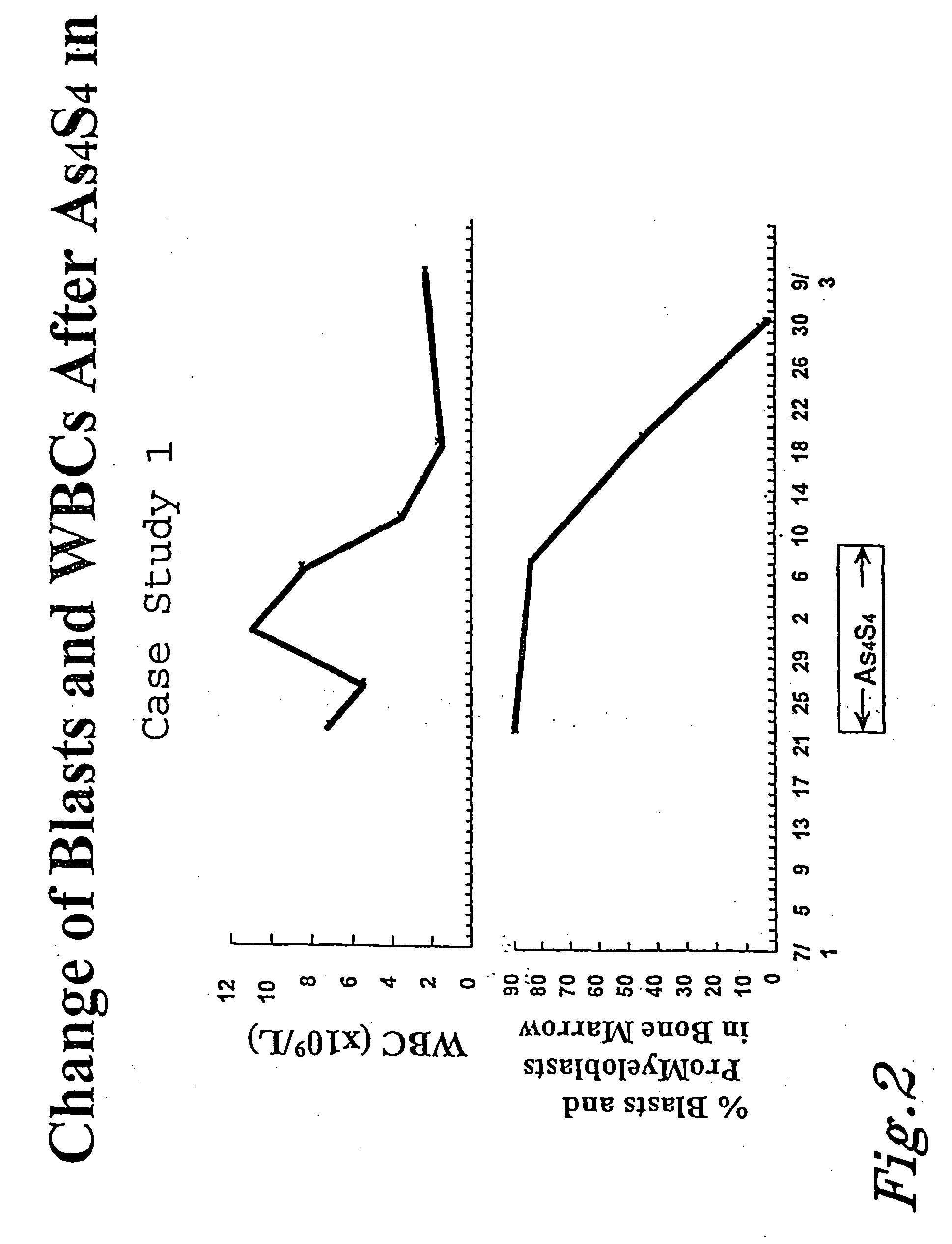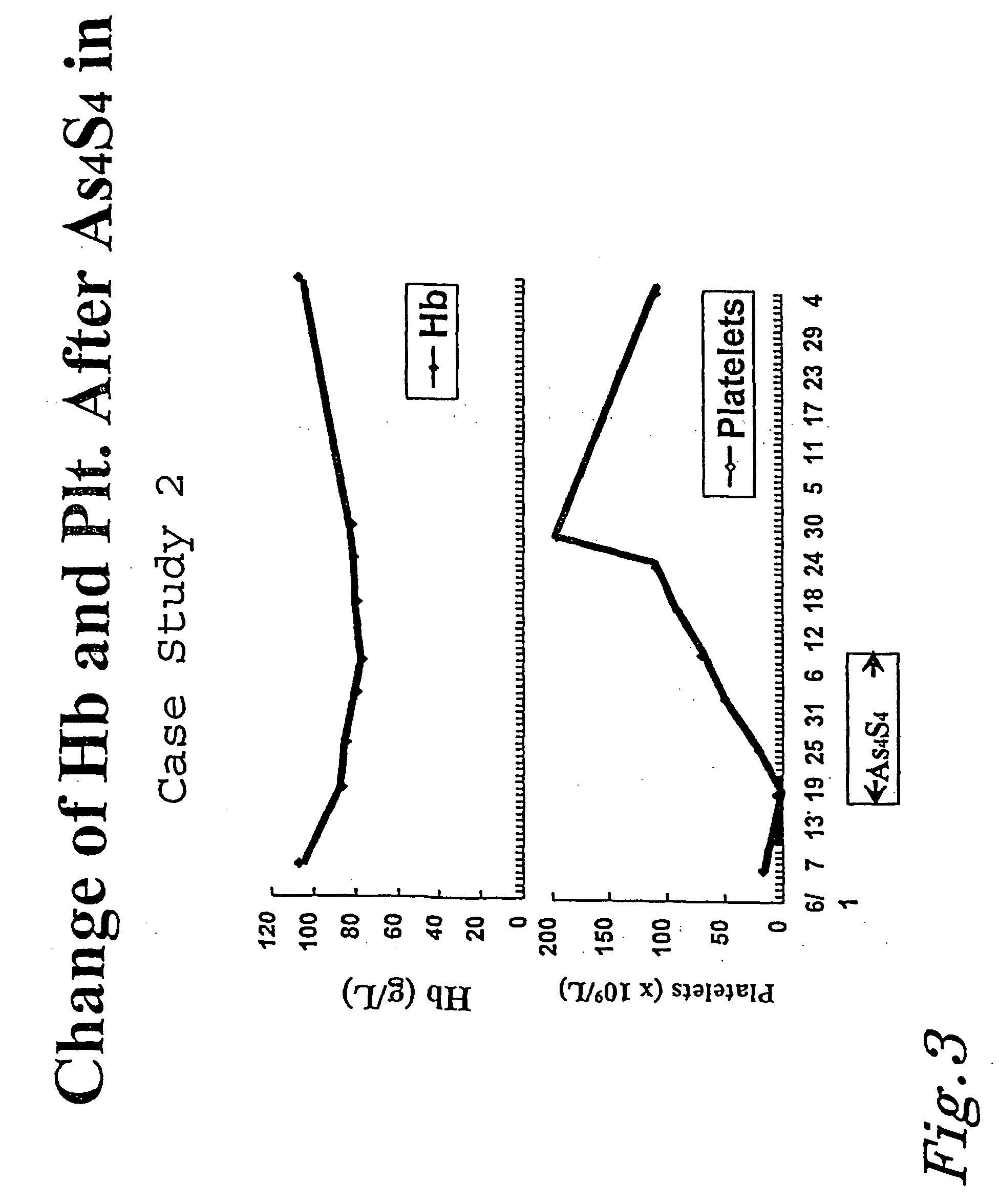Arsenic sulfide compounds and derivatives thereof for the treatment of malignancies
a technology of arsenic sulfide compounds and derivatives, which is applied in the direction of biocide, drug compositions, plant/algae/fungi/lichens ingredients, etc., can solve the problems of loss of pml and/or nb functions, its toxicity is well known, and realgar alone has never been suggested or used to treat cancer, etc., to achieve safe and effective use, broad applicability in the treatmen
- Summary
- Abstract
- Description
- Claims
- Application Information
AI Technical Summary
Benefits of technology
Problems solved by technology
Method used
Image
Examples
case study 1
[0087] Case Study 1
[0088] A 35 year old male was diagnosed with APL on Jul. 22, 1997, after noticing onset of symptoms the previous June. The patient had white blood cell counts of 7.04.times.10.sup.9 / L, hemoglobin 9 gm%, and platelet levels at 34.0.times.10.sup.9 / L. Cytogenetic analysis showed the (15;17) translocation, and PCR showed PML-RAR.alpha.(+). One day of ATRA treatment was given to the patient prior to beginning arsenic disulfide treatment. The treatment per the above protocol began on Jul. 22, 1997. Treatment was discontinued on Aug. 19, 1997 after twenty-five days of treatment. On Aug. 28, 1997, tests revealed the patient was in complete remission, having blast cells and leukemic promyelocytes less than 5%. This level was reached after only 36 days of treatment according to the protocol. As shown in FIG. 1, the patient saw a marked increase in hemoglobin and platelet levels. FIG. 2 shows the dramatic decrease in blasts and white blood cells after the arsenic disulfide t...
case study 2
[0089] Case Study 2
[0090] A 32 year old female was diagnosed with APL on May 24, 1996. She was treated for 40 days with ATRA, and subsequently Harringtonin / Ara-C in four courses. The patient met some success, and had a rest period of six months. Patient relapsed on Jun. 6, 1997. Her white blood cell count was 2.2.times.10.sup.6 / L, hemoglobin 10.7 gm%, and platelet count 1.5.times.10.sup.9 / L. Treatment with arsenic disulfide began on Jul. 9, 1997. The patient was treated according to protocol for 21 days. The patient went into complete remission on Jul. 28, 1997. FIG. 3 shows that the patient saw a change in hemoglobin and platelet levels. FIG. 4 shows the dramatic change in blasts and white blood cells after the arsenic disulfide treatment was used.
case study 3
[0091] Case Study 3
[0092] A 40 year old male was diagnosed as having chronic myeloid leukemia (CML) in February, 1959. At that time, he had a white blood cell count of 1.5.times.10.sup.1 / mm.sup.3 and a platelet level of 1.4.times.10.sup.5 / mm.sup.3. Initially, he was treated with Myleran. On Jan. 20, 1960, the white blood cell count was 3.15.times.10.sup.6 / mm.sup.-3 showing a differential count of 11% promyelocyte and myelocyte. The bone marrow picture showed increased cellularity with a preponderance of myeloid series with 21% of myelocytes. Patient was given 0.6 gram of arsenic disulfide twice daily. While being treated, blood and bone marrow pictures were controlled. The patient died, on Sep. 5, 1965 from infection unrelated to the arsenic sulfide treatment.
PUM
| Property | Measurement | Unit |
|---|---|---|
| time | aaaaa | aaaaa |
| time | aaaaa | aaaaa |
| concentration | aaaaa | aaaaa |
Abstract
Description
Claims
Application Information
 Login to View More
Login to View More - R&D
- Intellectual Property
- Life Sciences
- Materials
- Tech Scout
- Unparalleled Data Quality
- Higher Quality Content
- 60% Fewer Hallucinations
Browse by: Latest US Patents, China's latest patents, Technical Efficacy Thesaurus, Application Domain, Technology Topic, Popular Technical Reports.
© 2025 PatSnap. All rights reserved.Legal|Privacy policy|Modern Slavery Act Transparency Statement|Sitemap|About US| Contact US: help@patsnap.com



